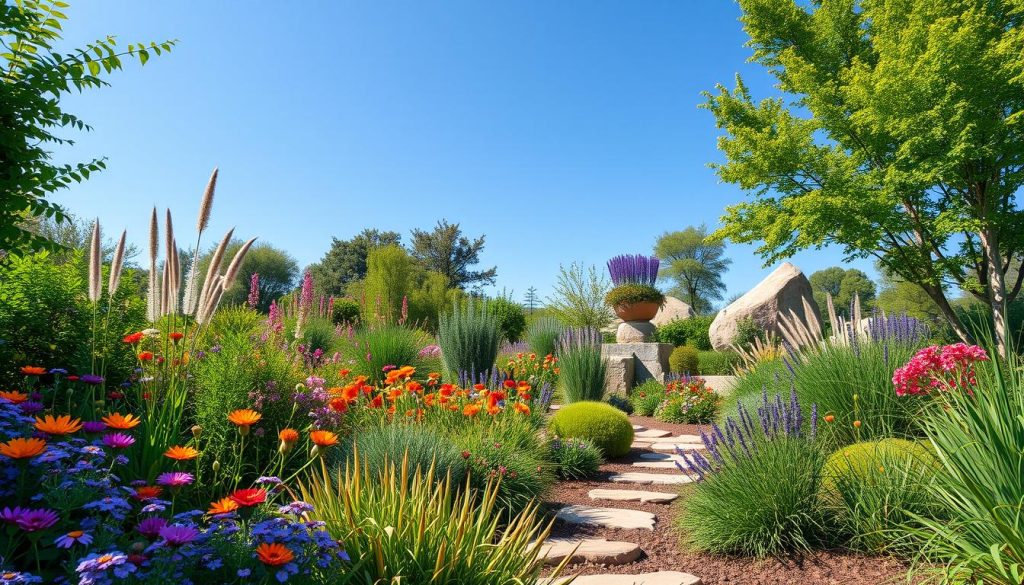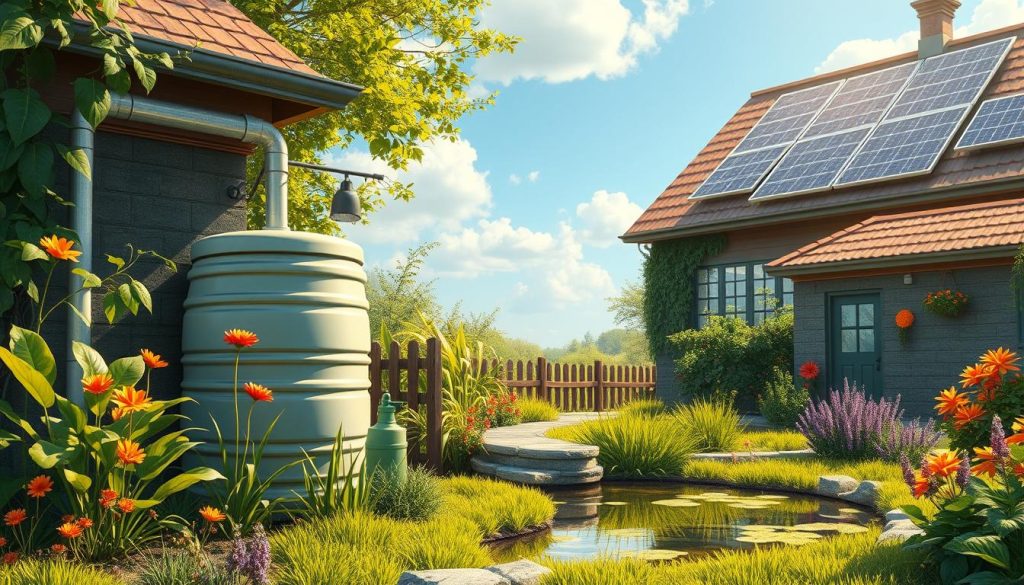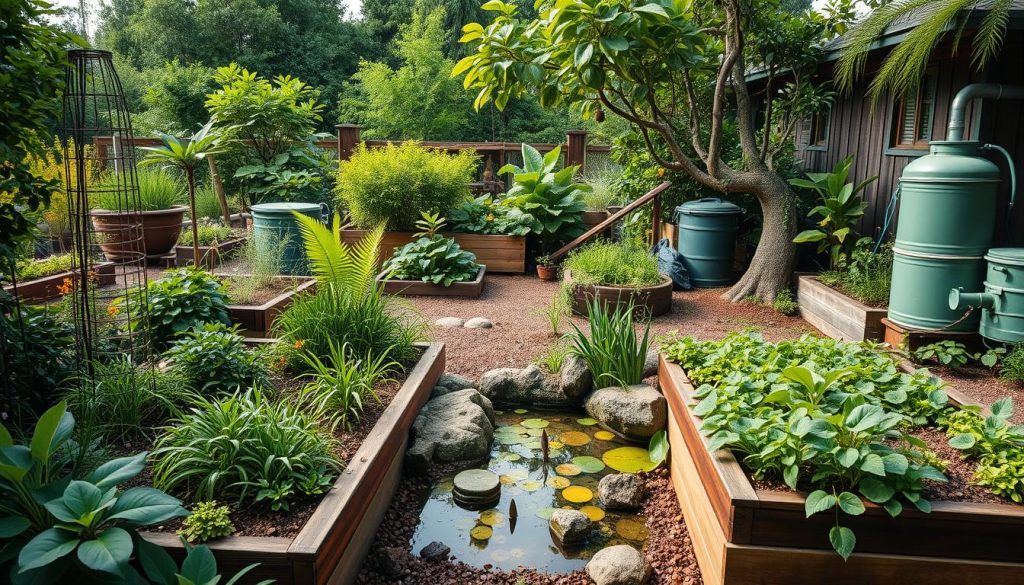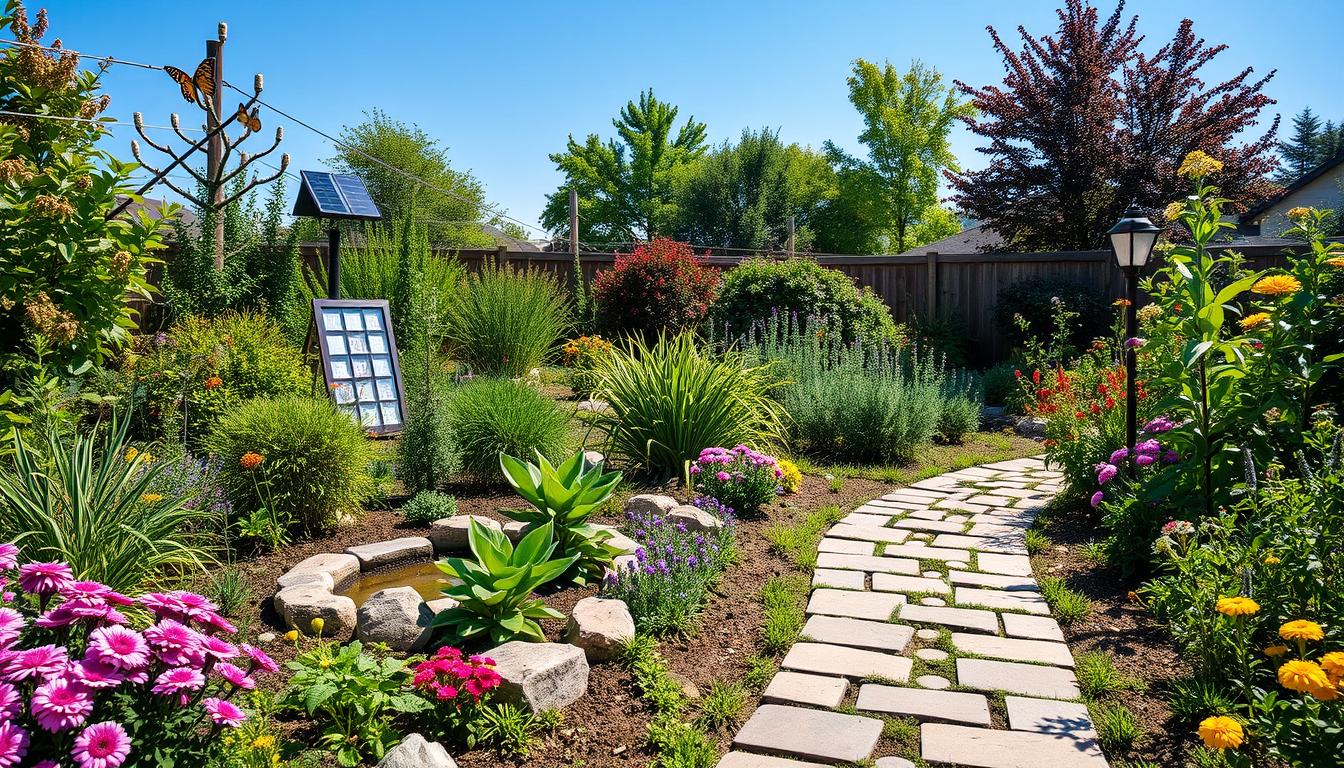I’m excited to share my passion for sustainable landscaping with you. As a homeowner, I’ve found that eco-friendly gardening makes my yard beautiful and helps the environment. It uses less water and needs little upkeep.
Sustainable landscaping is more than a trend. It’s a way to fight climate change in our backyards. I’ve seen how it boosts biodiversity and makes cities better places to live. With native plants and smart watering, we can work with nature, not against it.
In this guide, I’ll show you how to create an eco-friendly garden. You’ll learn to save money, use resources wisely, and enjoy a lush, green space. It’s good for you and the planet. Let’s explore sustainable landscaping together!
Understanding Sustainable Landscaping: A Green Revolution
I’ve seen a big change in gardening and landscaping. This green revolution is changing how we design our outdoor spaces. Sustainable landscaping is more than a trend; it’s crucial for our planet’s future.
Eco-Friendly Gardening Practices
Eco-friendly gardening works with nature, not against it. I use native plants that do well in our area and need less water. Composting kitchen scraps and yard waste makes soil rich, cutting down on chemical fertilizers.
Importance in Urban Environments
In cities, sustainable landscaping is key. Green spaces fight the urban heat island effect, improve air quality, and cut energy costs. I’ve seen how rooftop gardens and vertical plantings turn concrete jungles into green, livable areas.
Environmental Benefits of Green Solutions
The effects of sustainable landscaping go beyond individual yards. It saves water, cuts pollution, and helps local wildlife. By choosing green solutions for my yard, I’m helping the planet. This green revolution in landscaping is a small but important step towards a sustainable future.
| Sustainable Practice | Environmental Benefit |
|---|---|
| Native Plant Use | Supports local ecosystems |
| Rainwater Harvesting | Conserves water resources |
| Composting | Reduces landfill waste |
Native Plants: The Foundation of a Sustainable Landscape

I’ve learned that native plants are key to a thriving, sustainable garden. They’ve adapted to local climates over thousands of years. This makes them ideal for eco-friendly gardens.
By picking native species, my garden needs less care. It also supports local wildlife, boosting biodiversity in my area.
In my experience, native plants bring many benefits to sustainable landscaping:
- They need less water
- They resist local pests and diseases
- They attract pollinators like bees and butterflies
- They offer food and shelter for native wildlife
I’ve looked into popular native plants for different areas in the United States. Here’s a table with some examples:
| Region | Native Plant | Ecosystem Benefit |
|---|---|---|
| Northeast | Eastern Redbud | Early nectar source for pollinators |
| Southeast | Purple Coneflower | Attracts butterflies and birds |
| Midwest | Prairie Blazing Star | Supports native bee populations |
| Southwest | Desert Marigold | Drought-tolerant, attracts beneficial insects |
| Northwest | Western Columbine | Provides nectar for hummingbirds |
By adding these native plants to my garden, I’ve made a sustainable landscape. It’s not just beautiful but also helps my local ecosystem. It’s a win-win for my yard and the environment!
Water Conservation Techniques for Your Eco-Friendly Garden

I’m excited to share some effective water conservation techniques for your eco-friendly garden. By implementing these strategies, we can create beautiful landscapes while preserving our precious water resources.
Efficient Irrigation Systems and Smart Watering Practices
Drip irrigation and soaker hoses are great for water-efficient gardening. They deliver water directly to plant roots, reducing evaporation and waste. Watering early in the morning or late in the evening helps minimize water loss due to evaporation.
Rainwater Harvesting: Maximizing Natural Resources
Rainwater harvesting is a fantastic way to reduce reliance on municipal water supplies. I’ve installed rain barrels at my downspouts to collect rainwater for garden use. This simple setup provides free water for my plants and helps manage stormwater runoff.
Xeriscaping: Designing Drought-Resistant Landscapes
Xeriscaping focuses on using drought-tolerant plants and efficient water management. I’ve embraced this technique in my garden by grouping plants with similar water needs and using mulch to retain soil moisture.
| Water Conservation Technique | Benefits | Implementation Tips |
|---|---|---|
| Drip Irrigation | Reduces water waste, targets plant roots | Install along plant rows, use timers |
| Rainwater Harvesting | Free water source, reduces runoff | Connect rain barrels to downspouts |
| Xeriscaping | Drought-resistant, low maintenance | Choose native plants, use mulch |
By combining these water conservation techniques, I’ve created a sustainable garden that thrives with minimal water usage. It’s amazing how small changes can make a big difference in preserving our water resources while maintaining a beautiful landscape.
Organic Lawn Care: Nurturing Your Grass Naturally
Organic lawn care has changed the game for me. It lets us grow lush, healthy grass without harming the environment. I’ve found some natural methods that have transformed my yard.
Natural fertilizers are key in organic lawn care. I use compost, grass clippings, and bone meal to feed my lawn. These slow-release nutrients help my grass grow strong and green. They also make the soil better for water and air to reach the roots.
Keeping pests away in eco-friendly gardening is easy. Neem oil and diatomaceous earth work great to keep bugs off. For bigger pests, I attract birds and beneficial insects to help out.
How we mow our lawn is important in organic care. I keep my grass at 3 inches to shade the soil and save water. This also stops weeds and makes the roots stronger.
| Organic Lawn Care Benefits | Impact |
|---|---|
| Improved Soil Health | Better water retention and nutrient availability |
| Reduced Environmental Impact | Less chemical runoff, safer for wildlife |
| Safer Outdoor Spaces | No harmful chemicals for children and pets |
| Long-term Cost Savings | Reduced need for water and fertilizers |
Organic lawn care has made my yard a thriving, green space. It’s safe for my family and the planet. This journey is rewarding and follows eco-friendly gardening principles.
Permaculture Design: Creating Self-Sustaining Ecosystems

Permaculture design is a new way to landscape. It makes our backyards into thriving, self-sustaining ecosystems. It’s a big change for those who want to live in harmony with nature.
Principles of Permaculture in Landscaping
Permaculture design has key principles that follow nature. These include:
- Working with nature, not against it
- Maximizing energy efficiency
- Using and valuing renewable resources
- Producing no waste
- Integrating rather than segregating
By using these principles, I’ve seen landscapes change into productive, easy-to-care-for spaces.
Implementing Food Forests and Edible Landscapes
Food forests and edible landscapes are key in permaculture design. They use food-producing plants like woodland ecosystems. Layering plants, from tall fruit trees to herbs, makes a diverse, productive area.
It’s amazing to see how these landscapes give fresh food and help local wildlife.
Enhancing Biodiversity Through Permaculture Practices
Permaculture practices boost biodiversity. By creating diverse plant communities, we attract many beneficial insects, birds, and wildlife. Adding water features, like ponds or rain gardens, helps even more.
It’s rewarding to see these ecosystems become more self-sustaining over time. They need less help and give more benefits.
Green Infrastructure: Integrating Nature into Urban Spaces
Green infrastructure is changing urban areas in the United States. Cities are using sustainable landscaping to make places healthier and more livable. Rain gardens and green roofs are turning cities into green spaces.
Bioswales are landscaped channels that slow down stormwater runoff. They prevent flooding and improve water quality. Rain gardens soak up excess water and beautify neighborhoods.
Green roofs are a big deal in cities. They cool buildings, save energy, and support wildlife. I’ve seen buildings with green roofs and they’re amazing.
Adding nature to cities has many benefits. It improves air and reduces noise pollution. It’s good for people and the planet.
| Green Infrastructure Element | Primary Benefits | Urban Application |
|---|---|---|
| Rain Gardens | Stormwater management, water filtration | Residential areas, parks |
| Bioswales | Flood prevention, pollutant removal | Along streets, parking lots |
| Green Roofs | Energy efficiency, habitat creation | Commercial buildings, schools |
| Urban Forests | Air purification, temperature regulation | City-wide planning |
As cities grow, green infrastructure is key. Sustainable landscaping makes cities strong and eco-friendly. It’s a smart investment for our future.
Urban Forestry: The Role of Trees in Sustainable Landscaping
Urban forestry is crucial for sustainable landscaping. Trees make cities greener and more livable. Let’s look at how urban trees affect our environment and how to care for them.
Selecting Tree Species for Urban Environments
Choosing the right trees for cities is key. I look for species that do well in urban areas. Native trees are often the best, as they fit local climates and need less care. Oak, maple, and elm are good options.
Benefits of Urban Trees
Trees in cities have many benefits. They clean the air by filtering pollutants and making oxygen. They also cool cities, reducing the heat island effect. Plus, they provide homes for wildlife, boosting city biodiversity.
| Benefit | Impact |
|---|---|
| Air Quality Improvement | Up to 24% reduction in air pollutants |
| Temperature Regulation | 2-8°F cooler under tree canopy |
| Carbon Sequestration | 48 lbs CO2 absorbed per year per mature tree |
Tree Care for Long-Term Sustainability
Proper care is essential for urban trees. I focus on regular pruning, deep watering, and protecting roots. Mulching helps keep moisture in and weeds out. By caring for trees, we ensure their benefits last for years.
Urban forestry is vital for sustainable landscaping. With the right trees and care, they improve air quality and make cities better. I urge everyone to plant and care for trees for a greener future.
Sustainable Landscaping: Balancing Aesthetics and Ecology
I often think about the balance between beauty and sustainability in landscaping. Homeowners face a challenge: making their outdoor spaces look good while being eco-friendly. The good news is, sustainable landscaping can do both.
When designing my garden, I choose native plants for their colors and textures. These plants are not only beautiful but also need less water and care. I mix flowering perennials, ornamental grasses, and shrubs to make my garden change with the seasons.
To make my garden more interesting, I use natural elements like rocks and logs. These features are homes for insects and small animals, making my garden better for the environment. I also have a small water feature that draws birds and butterflies, adding to the garden’s life.
Sustainable landscaping doesn’t mean giving up on style. I’ve found that using eco-friendly materials like permeable pavers and recycled wood can make beautiful paths and seating areas. These materials add to the garden’s beauty while being kind to the planet.
By following sustainable landscaping, I’ve made an outdoor space that’s a pleasure to see and good for the environment. It shows that with careful design, we can have gardens that are both stunning and eco-friendly.
DIY Eco-Friendly Landscaping Projects to Get Started
I’m excited to share some easy DIY eco-friendly landscaping ideas with you! These projects are perfect for beginners who want to try sustainable gardening. Let’s start with a simple rain garden. You can create one by digging a shallow depression in your yard and planting water-loving native plants.
This helps manage stormwater runoff and adds beauty to your landscape.
Building a compost bin is another great green solution for your yard. You can make one using wooden pallets or wire mesh. It’s a fantastic way to recycle kitchen scraps and yard waste while creating nutrient-rich soil for your plants.
If you’re looking to conserve water, installing a rain barrel is a smart move. You can collect rainwater from your roof and use it to water your garden during dry spells.
For those who love butterflies and bees, creating a pollinator-friendly garden is a rewarding project. Choose native flowering plants that bloom at different times of the year to provide food and habitat for these important creatures.
These DIY eco-friendly landscaping projects are just the beginning of your sustainable gardening journey. As you gain confidence, you’ll discover even more ways to make your yard a thriving, eco-friendly oasis.
